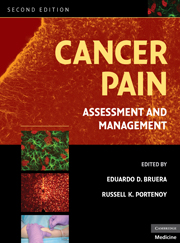Book contents
- Frontmatter
- Contents
- Contributors
- Preface
- SECTION I MECHANISMS AND EPIDEMIOLOGY
- SECTION II EPIDEMIOLOGY AND SYNDROMES
- SECTION III ASSESSMENT
- SECTION IV PHARMACOLOGICAL TREATMENT
- 9 Pharmacology of analgesia: basic principles
- 10 Pharmacogenetic considerations in the treatment of cancer pain
- 11 Pharmacology of opioid analgesia: clinical principles
- 12 Opioid side effects and management
- 13 Antipyretic analgesics
- 14 Adjuvant analgesic drugs
- 15 Neuraxial analgesia
- SECTION V OTHER INTERVENTIONAL STRATEGIES
- SECTION VI REHABILITATION AND PSYCHOLOGICAL INTERVENTIONS
- SECTION VII THE ROLE OF ANTINEOPLASTIC THERAPIES IN PAIN CONTROL
- SECTION VIII PAIN IN SPECIAL POPULATIONS
- SECTION IX DIFFICULT PAIN PROBLEMS
- SECTION X SYSTEMS OF CARE
- Index
- Plate section
- References
15 - Neuraxial analgesia
from SECTION IV - PHARMACOLOGICAL TREATMENT
Published online by Cambridge University Press: 06 July 2010
- Frontmatter
- Contents
- Contributors
- Preface
- SECTION I MECHANISMS AND EPIDEMIOLOGY
- SECTION II EPIDEMIOLOGY AND SYNDROMES
- SECTION III ASSESSMENT
- SECTION IV PHARMACOLOGICAL TREATMENT
- 9 Pharmacology of analgesia: basic principles
- 10 Pharmacogenetic considerations in the treatment of cancer pain
- 11 Pharmacology of opioid analgesia: clinical principles
- 12 Opioid side effects and management
- 13 Antipyretic analgesics
- 14 Adjuvant analgesic drugs
- 15 Neuraxial analgesia
- SECTION V OTHER INTERVENTIONAL STRATEGIES
- SECTION VI REHABILITATION AND PSYCHOLOGICAL INTERVENTIONS
- SECTION VII THE ROLE OF ANTINEOPLASTIC THERAPIES IN PAIN CONTROL
- SECTION VIII PAIN IN SPECIAL POPULATIONS
- SECTION IX DIFFICULT PAIN PROBLEMS
- SECTION X SYSTEMS OF CARE
- Index
- Plate section
- References
Summary
Introduction
Improvements in the understanding of the pathophysiology of pain, increased availability of pharmacological agents, adoption of different modes of drug administration, and development of comprehensive multidisciplinary care all have contributed to increasing the number of patients with effective control of cancer pain. The Guidelines for Cancer Pain Relief established by the World Health Organization (WHO) have been useful in emphasizing the effectiveness of oral morphine as a mainstay of cancer pain treatment. Although the analgesic “ladder” drew attention to the importance of using opioids of increasing potency and adding adjuvant therapies as necessary, the strategy today is to tailor the ingredients of a multimodal oral regimen to each patient's requirements at a particular stage of the disease. Several algorithms exist for the treatment of cancer pain, including the WHO Cancer Pain Ladder and the Agency for Healthcare Policy and Research (AHCPR) and National Cancer Care Network (NCCN) cancer pain treatment guidelines. However, 10%–20% of patients will require more intensive measures to control pain, particularly in the terminal phases of their illness. Treatment options include primary therapies such as radiotherapy, chemotherapy, and surgery to reduce pain in specific cases; parenteral or spinal administration of analgesic agents; neurolytic blocks; and surgical neuroablative procedures. In a prospective study of 2118 patients with cancer pain managed according to WHO guidelines, neuraxial analgesic administration (epidural and intrathecal) was used in 3% of the patients.
- Type
- Chapter
- Information
- Cancer PainAssessment and Management, pp. 287 - 312Publisher: Cambridge University PressPrint publication year: 2009



